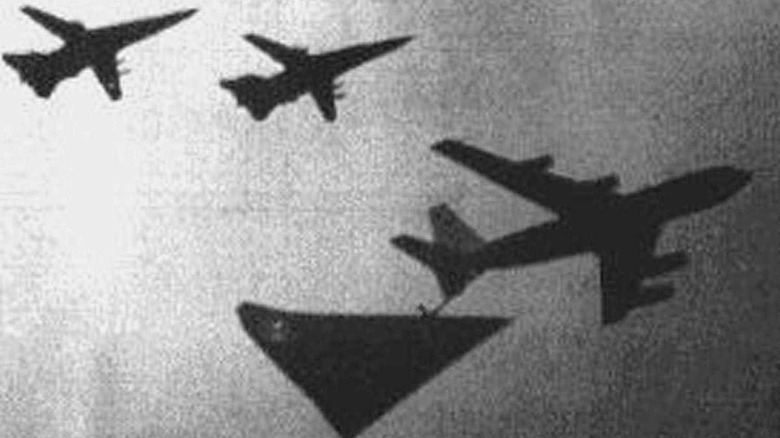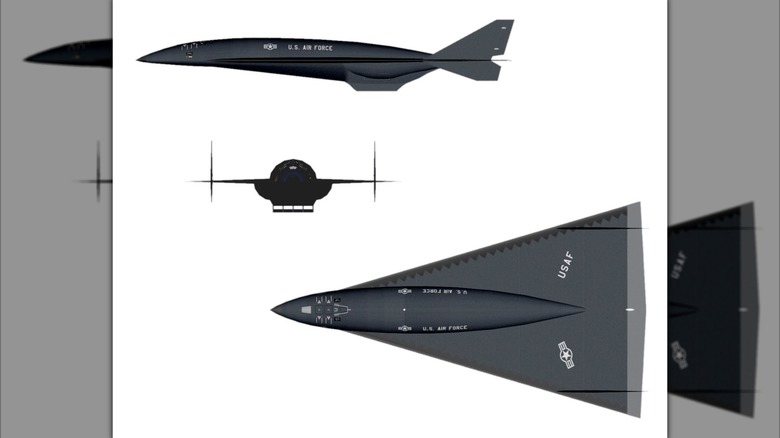Does The Aurora Spy Plane Really Exist?
The development of many of the world's warplanes — especially those in the modern era — is cloaked in rumors and conflated reports of unidentified aerial phenomena. Sometimes, they are massaged to fit narratives explaining mysterious environmental oddities (i.e., mysterious sonic booms) or any number of covert government installations. The United States military does have a well-documented history of building and testing cutting-edge technology — and summarily denying anything exists. Take, for instance, the development cycle for any and all of the Stealth aircraft or the SR-82 Darkstar, to name just a few.
The SR-91 Aurora was reported to be the hypersonic, high-altitude Intelligence, Surveillance, and Reconnaissance (ISR) aircraft capable of reaching speeds of nearly Mach 5 at altitudes of 90,000 feet. It was meant to replace the long-in-the-tooth SR-71 Blackbird that first took flight in 1964 and became the world's fastest plane in 1976, screaming through the sky at 2,193 miles per hour (over three times the speed of sound). While that's still impressive, it's akin to tooling along in the slow lane now (check out the record-shattering speed of NASA's scramjet-powered X-43).
The media first caught wind of "Aurora" in 1985 during a congressional appropriation hearing where the name was attached to a Pentagon budget request for the Blackbird and U-2 projects. Then, in 1989, an oil exploration engineer from the Royal Observer Corps named Chris Gibson claimed he spotted a triangle-shaped plane flying high over the North Sea escorted by two fighter jets as it was being refueled in the air by a KC-135 tanker, which further fanned the flames of speculation surrounding this latest clandestine plane.
Skyquakes, Area 51, and black programs oh my!
In the early 1990s, several skyquakes (mysterious sonic booms) were heard in the skies over Los Angeles and were said to be made by the SR-91 as it took off from Groom Lake, Nevada (Area 51). In 1993, the Fox Network's "The X-Files" premiered. The show's second episode ("Deep Throat") involved UFOs, experimental aircraft, and technology with stealth weaponry that was said to be directly inspired by the rumors surrounding the Aurora.
The following year (1994), a book was released by Ben Rich, the former director of Lockheed Martin's Skunk Works, the division that built the F-117A Nighthawk, the U-2, and SR-71 Blackbird. Skunk Works was also supposedly working on the SR-91. According to Rich, during the early days of the stealth bomber competition, funding came from "a secret stash in the Air Force budget." Ironically, the Aurora code name was randomly given to the B-2 stealth bomber project as a whole by a colonel in the Air Force "black program" office at the Pentagon.
Rich claims the media picked up on the name, connected some random dots, and somehow attributed it all to the SR-91 specifically, although he claims no such plane ever existed. Yet, the story of the Aurora would not die. A report was released several years later (May 2006) by the British Ministry of Defence that claimed the United States Air Force was planning to make a supersonic vehicle capable of going Mach 4 – 6, which fit the reported speed parameters for the Aurora.
Is the the Aurora spy plane fact or fiction?
That same year, acclaimed aviation writer Bill Sweetman went on record stating his 20 years of experience in examining military budgets and "tracking untraceable dollars and code names" believed the Air Force's 2006 operating budget — that included a $9-billion black hole — may very well be the smoking gun proving the Aurora was in the works. At the time, other clandestine projects were in the works simultaneously and were likely where this money was going.
Aurora probably never existed, at least not a clandestine hypersonic one. However, an aircraft with the "Aurora" designation does exist — the CP-140 Aurora (another one of Lockheed's many jets made over the years), a maritime patrol plane used for antisubmarine warfare by the Royal Canadian Air Force.
The advancement of spy satellites that are constantly in orbit around the globe and high-flying reconnaissance drones that can be remotely operated from afar have made big-budget hypersonic spy planes unnecessary in this day and age. The U.S. government has consistently denied its existence, and the words of the very man on the inside who would know if it did exist support those claims. He even gives logical reasons for why it became a thing in the first place, all of which make a stronger case than all the vague circumstantial evidence. In the end, the true (and boring) story around the SR-91 is far less exciting than the tremendously tall tale/urban legend/conspiracy theory that materialized.


